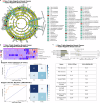Unravelling novel microbial players in the breast tissue of TNBC patients: a meta-analytic perspective
- PMID: 40925904
- PMCID: PMC12420793
- DOI: 10.1038/s41522-025-00816-5
Unravelling novel microbial players in the breast tissue of TNBC patients: a meta-analytic perspective
Abstract
Triple-negative breast cancer (TNBC) is the most aggressive subtype of breast cancer (BC), accounting for nearly 40% of BC-related deaths. Emerging evidence suggests that the breast tissue microbiome harbors distinct microbial communities; however, the microbiome specific to TNBC remains largely unexplored. This study presents the first comprehensive meta-analysis of the TNBC tissue microbiome, consolidating 16S rRNA amplicon sequencing data from 200 BC samples across four independent cohorts. Our analysis highlights the enrichment of Azospirillum genus as well as butyrate-producing species, namely Gemmiger formicilis and Anaerobutyricum soehngenii, potentially influencing TNBC aggressiveness and clinical outcomes. Additionally, our functional analyses reveal the involvement of the TNBC microbiome in several pathways associated with chronic inflammation, increased cellular proliferation, invasion, and metastasis. This study uncovers novel microbial players in TNBC that could explain its aggressiveness and poor prognosis, and warrants further investigation into microbiome-driven interventions.
© 2025. The Author(s).
Conflict of interest statement
Competing interests: The authors declare no competing interests.
Figures




References
-
- Orrantia-Borunda, E., Anchondo-Nuñez, P., Acuña-Aguilar, L. E., Gómez-Valles, F. O., & Ramírez-Valdespino, C. A. Subtypes of Breast Cancer. In H. N. Mayrovitz (Ed.), Breast Cancer. (Exon Publications, 2022). 10.36255/exon-publications-breast-cancer-subtypes - PubMed
-
- Leon-Ferre, R. A. & Goetz, M. P. Advances in systemic therapies for triple negative breast cancer. BMJ381, e071674 (2023). - PubMed
Publication types
MeSH terms
Substances
LinkOut - more resources
Full Text Sources

